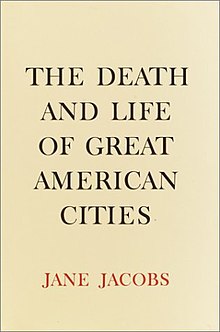This article needs additional citations for verification. (March 2018) |
 Hardcover edition | |
| Author | Jane Jacobs |
|---|---|
| Language | English |
| Subject | Urban planning |
| Publisher | Random House, New York City |
Publication date | 1961 |
| Publication place | United States |
| Media type | |
| Pages | 458 (1989 edition) |
| ISBN | 0-679-74195-X |
| OCLC | 500754 |
| Followed by | The Economy of Cities |
The Death and Life of Great American Cities is a 1961 book by writer and activist Jane Jacobs. The book is a critique of 1950s urban planning policy, which it holds responsible for the decline of many city neighborhoods in the United States.[1] The book is Jacobs' best-known and most influential work.[2]
Jacobs was a critic of "rationalist" planners of the 1950s and 1960s, especially Robert Moses, as well as the earlier work of Le Corbusier. She argued that urban planning should prioritize the needs and experiences of residents, and modernist urban planning overlooked and oversimplified the complexity of human lives in diverse communities. She opposed large-scale urban renewal programs that affected entire neighborhoods and built freeways through inner cities. She instead advocated for dense mixed-use development and walkable streets, with the "eyes on the street" of passers-by helping to maintain public order. She suggested preserving the existing city fabric, including old buildings and established communities.
- ^ "Jane Jacobs' Radical Legacy". Peter Dreier. Summer 2006. Archived from the original on 2006-09-28. Retrieved 3 August 2012.
- ^ Douglas, Martin (April 26, 2006). "Jane Jacobs, Urban Activist, Is Dead at 89". The New York Times. Retrieved February 17, 2016.